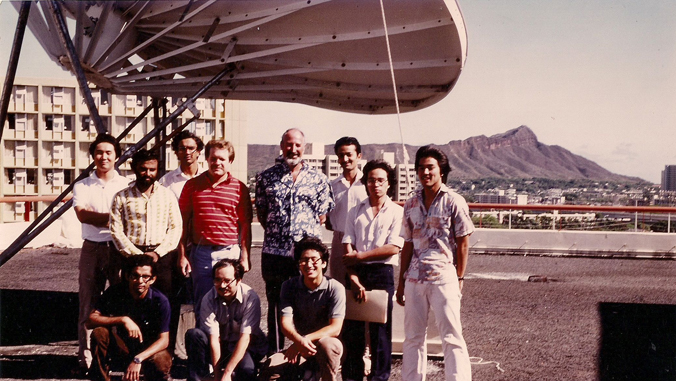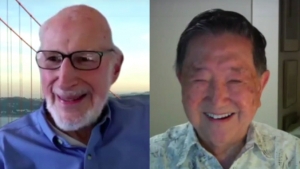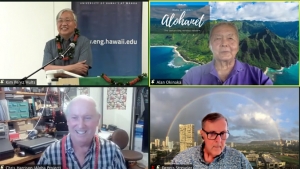
Hundreds of speakers, panelists and participants gathered virtually to celebrate the 50th anniversary of ALOHAnet with a symposium commemorating the pioneering system’s impact on technology worldwide. Born out of the University of Hawaiʻi at Mānoa College of Engineering in June 1971, the ALOHAnet protocol is the basis of all wireless communications—including mobile, satellite, cellular and WiFi.
“ALOHAnet and the ALOHA protocols all developed here absolutely changed the world enabling technologies for wireless communication and the internet,” UH President David Lassner said.
“The University of Hawaiʻi is competitive in the innovation and technology realm with anyone else in the world,” College of Engineering Dean Brennon Morioka said. “Not only are we continuing to do innovative and cutting edge work and research here today, but the university has a long history of it dating back well over 50 years and ALOHAnet is one of those primary examples on the kind of legacy that the University of Hawaiʻi and the College of Engineering can leave not just with our own community but beyond our shores.”
- Related UH News story: Pioneering wireless technology ALOHAnet honored as engineering milestone, October 13, 2020
50th anniversary symposium

Morioka and Lassner kicked off the event with opening remarks, followed by Gov. David Ige, a UH Mānoa electrical engineering alumnus.
“The power of a tier-one research institution to the State of Hawaiʻi is very evident and I am a proud graduate of the University of Hawaiʻi…It was a very challenging and exciting time. It was the birth of the personal computer and the whole notion of connecting individual devices all around the campus, initially, and then all around the state,” Ige said. “Today’s 50th anniversary celebration commemorates the past, the present, and most importantly, embraces the inspiration of the future of the State of Hawaiʻi.”
Pono Shim, president and CEO of Oʻahu Economic Development Board (OEDB), described the impact of ALOHAnet in OEDB’s mission to be a leading agent in the growth, retention and recruitment of businesses that support appropriate jobs for the people of Hawaiʻi.
Keynote presentations honored the late Norman Abramson, who died in December 2020. Abramson co-created ALOHAnet, and served as a professor of electrical engineering and chair of the Information and Computer Sciences Department. Presentations were delivered by Abramson’s wife, Joan; Frank Kuo, fellow ALOHAnet co-creator; Vint Cerf, Google’s chief internet evangelist and “Father of the Internet”; and Robert Kahn, chairman, CEO and president of the Corporation for National Research Initiatives.

The first panel featured three College of Engineering alumni who worked on the ALOHAnet team, Alan Okinaka, Chris Harrison and Dennis Streveler. They shared fond memories of working on ALOHAnet and what the experience has done for them in their careers. This panel was moderated by Professor Anthony Kuh.
“We define technology as the application of basic science, but at ALOHAnet we looked at the application of technology and that was really exciting,” said Okinaka, who worked on ALOHAnet from 1969–76. “When I left in 1976, I went to GTE Hawaiian Tel, the thing that got me was we were going into data communications and even there, what I had learned from working with ALOHAnet stayed with me.”
Two panels followed on the impact of ALOHAnet on academia and the tech industry. Tony Ephremides, University of Maryland College Park professor moderated the first panel and Monisha Ghosh, former Federal Communications Commission CTO and current professor at the University of Chicago, moderated the second.
Endowed scholarship honoring Abramson
A new endowed scholarship in Abramson’s name was announced at the symposium. The Norman Abramson ALOHANet Endowed Scholarship will benefit graduate students interested in research related to wireless data networks. The endowment was started by a group of people involved with ALOHAnet who loved and respected Abramson.
“Having an endowed scholarship under Norm’s name—knowing that it’s there to support students in their pursuits of education and knowledge—goes beyond just the academics in the classroom. It’s really about supporting the people,” Morioka said.
ALOHAnet’s impact on students
It is encouraging to see students know that just because we’re here in the middle of the Pacific—one of the most isolated land masses on Earth—that some of the greatest things can be developed right here at home.
—Morioka
Morioka said the College of Engineering faculty and staff often talk about ALOHAnet with students, and their reactions start with amazement discovering that all wireless communications began at UH Mānoa.
“Then it becomes an inspirational aspect,” Morioka said. “It’s ‘wow, we did it before. This is something that we can continue to be a part of, perpetuating the legacies that the university and the College of Engineering has really worked so hard in trying to develop.’”
Morioka added, “It is encouraging to see students know that just because we’re here in the middle of the Pacific—one of the most isolated land masses on Earth—that some of the greatest things can be developed right here at home.”
This work is an example of UH Mānoa’s goals of Enhancing Student Success (PDF) and Excellence in Research: Advancing the Research and Creative Work Enterprise (PDF), two of four goals identified in the 2015–25 Strategic Plan (PDF), updated in December 2020.
—By Marc Arakaki

